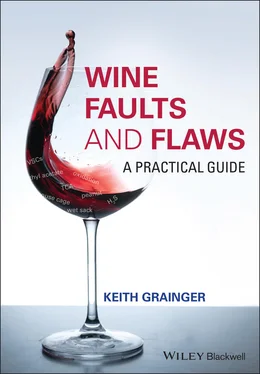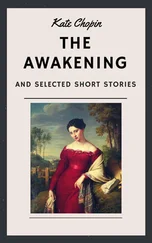Keith Grainger - Wine Faults and Flaws
Здесь есть возможность читать онлайн «Keith Grainger - Wine Faults and Flaws» — ознакомительный отрывок электронной книги совершенно бесплатно, а после прочтения отрывка купить полную версию. В некоторых случаях можно слушать аудио, скачать через торрент в формате fb2 и присутствует краткое содержание. Жанр: unrecognised, на английском языке. Описание произведения, (предисловие) а так же отзывы посетителей доступны на портале библиотеки ЛибКат.
- Название:Wine Faults and Flaws
- Автор:
- Жанр:
- Год:неизвестен
- ISBN:нет данных
- Рейтинг книги:4 / 5. Голосов: 1
-
Избранное:Добавить в избранное
- Отзывы:
-
Ваша оценка:
- 80
- 1
- 2
- 3
- 4
- 5
Wine Faults and Flaws: краткое содержание, описание и аннотация
Предлагаем к чтению аннотацию, описание, краткое содержание или предисловие (зависит от того, что написал сам автор книги «Wine Faults and Flaws»). Если вы не нашли необходимую информацию о книге — напишите в комментариях, мы постараемся отыскать её.
FLAWS
Wine Faults and Flaws: A Practical Guide
An essential guide to the faults and flaws that can affect wine
Wine Faults and Flaws — читать онлайн ознакомительный отрывок
Ниже представлен текст книги, разбитый по страницам. Система сохранения места последней прочитанной страницы, позволяет с удобством читать онлайн бесплатно книгу «Wine Faults and Flaws», без необходимости каждый раз заново искать на чём Вы остановились. Поставьте закладку, и сможете в любой момент перейти на страницу, на которой закончили чтение.
Интервал:
Закладка:
| Animal | Pinot Noir, high level of Brettanomyces |
|---|---|
| Aniseed | Malbec |
| Banana | Gamay, carbonic maceration |
| Blackberry | Grenache, Merlot, Shiraz (Syrah) |
| Blackcurrant | Cabernet Sauvignon |
| Bramble | Zinfandel |
| Cedar | Oak ageing, Cabernet Sauvignon |
| Cherry – black | Cabernet Sauvignon, Merlot, Pinot Noir (very ripe) |
| Cherry – red | Pinot Noir (fully ripe), Sangiovese, Tempranillo |
| Chocolate – dark | Cabernet Sauvignon, Shiraz |
| Cinnamon | Cabernet Sauvignon |
| Clove | Grenache |
| Coconut | Oak ageing |
| Game | Pinot Noir |
| Grass | Unripe grapes |
| Herb (mixed) | Grenache, Merlot, Sangiovese |
| Leafy | Pinot Noir |
| Leather | Shiraz (Syrah), aged wines |
| Liquorice | Grenache, Malbec, Cabernet Sauvignon |
| Meat | Pinotage |
| Metal | Cabernet Franc |
| Mint | Cabernet Sauvignon (especially cool climate) |
| Pencil shavings | Cabernet Sauvignon |
| Pepper – bell | Cabernet Sauvignon, Carmenère |
| Pepper – ground black | Shiraz (Syrah) |
| Pepper – white | Grenache |
| Plum – black | Merlot |
| Plum – red | Merlot, Pinot Noir (overripe) |
| Redcurrant | Barbera |
| Raspberry | Cabernet Franc, Grenache, Pinot Noir (ripe) |
| Roses | Nebbiolo |
| Smoke | Oak ageing |
| Soy sauce | Carmenère (very ripe) |
| Stalky | Wet vintage, unripe grapes, inclusion of stalks |
| Strawberry | Grenache, Pinot Noir (just ripe), Merlot, Tempranillo |
| Tar | Nebbiolo, Shiraz |
| Tea | Merlot |
| Toffee | Merlot |
| Toast | Oak ageing |
| Tobacco | Cabernet Sauvignon |
| Truffle | Nebbiolo |
2.7.10 Other Observations
2.7.10.1 Texture
The texture of a wine should be considered and crucially the balance of the characteristics already discussed. The easiest way to understand texture is by imagining running the tips of your fingers over the skin of various parts of the body of people of different ages and professions: the smooth, soft face of a model, the hands of a cashier, the weathered face of a deep‐sea‐fisherman, the pre‐shave chin of a builder. The texture of a wine might be described as silky , velvety , smooth , or coarse . Several wine faults impact upon texture, including some faults resulting from the actions of lactic acid bacteria – see Chapter 11.
Bubbles or spritz, if present, give tactile sensations on the tongue. In a poor quality sparkling wine, they are very aggressive, whilst a creamy feeling mousse is indicative of the well‐integrated carbon dioxide in a good quality example. Thus in the case of sparkling wines, the mousse might be described as delicate , creamy , or aggressive .
2.7.10.2 Balance
Balance is the interrelationship between all the taste and tactile sensations and the components that create them. If anyone or a small number of them dominate, or if there is a deficiency of any of them, the wine is unbalanced. An easy to understand example is that a white wine described as sweet or luscious but with a low acidity will be flabby and cloying. In other words, it is unbalanced. A red wine with a light body, light flavour intensity, low to medium alcohol but high tannin will feel very hard astringent and unbalanced. A balanced wine has all the sensations in proportions that make the wine a harmonious whole. In a well‐balanced wine, the sensations are seamlessly integrated.
If any component or several components are making the wine unbalanced, these should be noted. However, the state of maturity of a wine is an important consideration. Whilst a very low quality wine may never be in balance at any stage in its life‐cycle, a high‐quality wine, particularly reds, will often only achieve balance when approaching maturity. Tannins and acidity may dominate in youth. The taster needs to evaluate all the components and the structure of the wine to anticipate how these will be interrelated at maturity. Balance is a major consideration when assessing wine quality, and wines that are substantially ‘out‐of‐balance’ may be considered as flawed, as will be briefly discussed in Chapter 14.
2.7.11 Finish – Length
Put simply, the length of the finish and aftertaste is the best indicator of wine quality. The terms ‘finish’, ‘aftertaste’, and ‘length’ sometimes give rise to confusion. ‘Finish’ refers to the final taste sensations of the wine as it is swallowed or spat. ‘Aftertaste’ encompasses the sensations that remain and develop as we breathe out, whilst ‘length’ is the measure of time for which finish and aftertaste last. To determine length, after the taster has spat the wine, they should breathe out slowly, concentrate on the sensations observing any changes or development, and count the number of seconds that the taste sensations last. The sensations delivered by poor quality and inexpensive wines will disappear after 5–10 seconds (short length), and any remaining sensations are likely to be unpleasant. Acceptable quality wines will have a length of 11–20 seconds (medium length), good wine 20–30 seconds (long length) and outstanding wines a length of 30 seconds or more (very long length). Truly excellent wines may have a length that runs into minutes. It is important that throughout this test of length, the sensations remain in tune with the actual taste of the wine, and also that everything remains in balance. The taster may wish to adjust the number of seconds timing given above for the various lengths to their own, individual perceptions.
Finish may be considered on a scale that runs from short , to very long . If any unpleasant characteristics dominate the length, they will affect the quality and should be noted accordingly. For example, a wine with unripe tannins and other bitter compounds might have a medium or even longer length. However, the bitterness will dominate, and the nature of the length becomes increasingly unpleasant. Sometimes faults that might not have manifested themselves previously become apparent on the finish of the wine. On occasions, these may include haloanisoles at a medium level – see Chapter 3and smoke taint at a low level – see Chapter 12.
2.8 Assessment of Quality
2.8.1 Quality Level
Quality judgements are framework dependent. This poses a dilemma. Do we consider the quality of a wine only within the context of its peer group or against the entire wine world? Can a wine such as Beaujolais, which is usually made for early drinking in a soft, immediately approachable style, be described as outstanding quality even though it is carefully crafted, exquisitely perfumed, expressive of its origin and superior to most others of its type? The key to answering such questions is to be as objective as possible in the assessment, noting the quality of the wine, as perceived by the taster, according to the origin and price levels of the wine.
2.8.2 Reasons for Assessment of Quality
It is, of course, very possible that many wines of outstanding quality are not to our palate and, on occasions, simple wines may be very appealing. The reasons for our quality judgements should be logical and as possible. When reviewing the tasting assessment, consideration should be given to the intensity, concentration and complexity of nose and flavours on the palate, the structure of the wine, the balance, and length of finish. The following guidelines form a framework for quality assessments:
Читать дальшеИнтервал:
Закладка:
Похожие книги на «Wine Faults and Flaws»
Представляем Вашему вниманию похожие книги на «Wine Faults and Flaws» списком для выбора. Мы отобрали схожую по названию и смыслу литературу в надежде предоставить читателям больше вариантов отыскать новые, интересные, ещё непрочитанные произведения.
Обсуждение, отзывы о книге «Wine Faults and Flaws» и просто собственные мнения читателей. Оставьте ваши комментарии, напишите, что Вы думаете о произведении, его смысле или главных героях. Укажите что конкретно понравилось, а что нет, и почему Вы так считаете.












